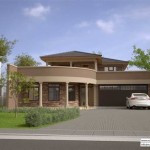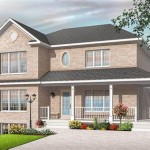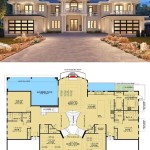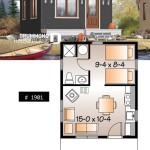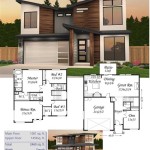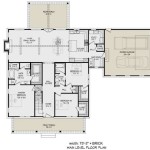Efficient house plans refer to layouts designed to optimize space, resources, and functionality within a home. They prioritize energy efficiency, sustainability, and livability, aiming to create comfortable and environmentally friendly living spaces.
One key example of an efficient house plan is the passive house concept. Passive houses are designed to minimize heat loss and gain through advanced insulation, airtight construction, and strategic placement of windows. This approach significantly reduces energy consumption for heating and cooling, resulting in a more sustainable and cost-effective home.
Efficient house plans incorporate several key elements to achieve their goals of sustainability, comfort, and functionality.
- Optimized Space Planning
- Energy-Efficient Design
- Natural Lighting
- Sustainable Materials
- Water Conservation
- Indoor Air Quality
- Smart Home Integration
- Cost-Effectiveness
By considering these aspects, efficient house plans create homes that are not only environmentally friendly but also enjoyable and affordable to live in.
Optimized Space Planning
Optimized space planning is a crucial aspect of efficient house plans. It involves strategically arranging rooms, hallways, and other spaces to maximize functionality, comfort, and flow while minimizing wasted space.
- Open Floor Plans: Open floor plans combine multiple rooms, such as the living room, dining room, and kitchen, into one large, interconnected space. This design creates a sense of spaciousness, improves natural light flow, and facilitates easier movement throughout the home.
- Multi-Purpose Rooms: Multi-purpose rooms serve multiple functions, allowing for better space utilization. For example, a guest room can also be used as a home office or a playroom for children.
- Efficient Storage Solutions: Built-in storage solutions, such as closets, shelves, and drawers, maximize vertical space and keep clutter off the floor. They also help maintain a clean and organized living environment.
- Flexible Spaces: Flexible spaces can be easily adapted to changing needs. For instance, a room initially designed as a nursery can be converted into a child’s bedroom or a home gym as the family grows.
By implementing these space-saving techniques, efficient house plans create homes that feel larger, more comfortable, and more functional, even within limited square footage.
Energy-Efficient Design
Energy-efficient design is a cornerstone of efficient house plans. It involves incorporating features and materials that minimize energy consumption for heating, cooling, and other household activities.
- Insulation: Proper insulation is essential for reducing heat loss and gain. Efficient house plans use high-performance insulation materials in walls, ceilings, and floors to maintain a comfortable indoor temperature year-round.
- Air Sealing: Air sealing involves sealing gaps and cracks around windows, doors, and other openings to prevent air leakage. This reduces heat loss and improves overall energy efficiency.
- High-Efficiency Windows: Energy-efficient windows have low U-factors and high solar heat gain coefficients. They allow natural light to enter while minimizing heat loss and heat gain.
- Energy-Efficient Appliances: Energy-efficient appliances, such as refrigerators, dishwashers, and washing machines, consume less energy to operate, reducing the overall energy footprint of the home.
By implementing these energy-efficient design principles, efficient house plans create homes that are more comfortable, reduce energy bills, and contribute to a greener environment.
In addition to the above, efficient house plans may also incorporate renewable energy sources, such as solar panels and geothermal systems, to further minimize reliance on fossil fuels and promote sustainable living.
Natural Lighting
Natural lighting plays a vital role in creating healthy, comfortable, and energy-efficient homes. Efficient house plans prioritize maximizing natural light to reduce reliance on artificial lighting, improve indoor air quality, and enhance overall well-being.
One key strategy is to incorporate large windows and skylights into the design. These openings allow ample natural light to penetrate deep into the home, reducing the need for electric lighting during the day. Additionally, windows and skylights can provide passive solar heating, helping to maintain a comfortable indoor temperature in colder months.
To optimize natural lighting, efficient house plans consider the orientation of the home on the building site. Placing windows and skylights on the south side allows for maximum exposure to sunlight throughout the day. Overhanging eaves or awnings can be used to shade windows during the summer, preventing excessive heat gain.
In addition to providing natural illumination, windows and skylights also offer numerous other benefits. They improve ventilation by allowing fresh air to circulate, reducing the risk of indoor air pollution. Natural light has also been shown to have positive effects on mood, sleep patterns, and overall health.
By carefully considering the placement and design of windows and skylights, efficient house plans harness the power of natural lighting to create homes that are not only energy-efficient but also healthier, more comfortable, and more enjoyable to live in.
Sustainable Materials
Sustainable materials play a crucial role in creating eco-friendly and healthy homes. Efficient house plans prioritize the use of sustainable materials that minimize environmental impact, promote resource conservation, and enhance indoor air quality.
One key aspect of sustainable materials is their durability and longevity. High-quality, durable materials can withstand wear and tear, reducing the need for frequent replacements and minimizing waste. For example, using hardwood flooring or ceramic tiles instead of carpeting can increase the lifespan of flooring materials, reducing the environmental impact associated with manufacturing and disposal.
Efficient house plans also consider the embodied energy of materials. Embodied energy refers to the energy required to extract, process, and transport materials. By choosing materials with low embodied energy, such as recycled materials or locally sourced materials, the overall environmental impact of the home can be reduced.
In addition to durability and embodied energy, efficient house plans prioritize materials that promote healthy indoor air quality. Low-VOC (volatile organic compound) materials, such as paints, sealants, and adhesives, help reduce indoor air pollution. Natural materials, such as wood, stone, and cork, are often preferred for their ability to regulate humidity and minimize the risk of mold and mildew.
By carefully selecting sustainable materials, efficient house plans create homes that are not only environmentally friendly but also healthier and more comfortable for occupants.
Water Conservation
Water conservation is a critical aspect of efficient house plans, as it promotes responsible water use, reduces strain on local water resources, and lowers utility bills.
- Low-Flow Fixtures: Low-flow fixtures, such as faucets, showerheads, and toilets, use less water without compromising performance. By installing low-flow fixtures, homeowners can significantly reduce their water consumption without sacrificing comfort or hygiene.
- Water-Efficient Appliances: Water-efficient appliances, such as dishwashers and washing machines, use less water per cycle. Look for appliances with the WaterSense label, which indicates that they meet specific water-efficiency criteria set by the US Environmental Protection Agency (EPA).
- Rainwater Harvesting: Rainwater harvesting systems collect and store rainwater from rooftops or other surfaces for later use. This water can be used for non-potable purposes, such as watering lawns or washing cars, reducing the reliance on municipal water supplies.
- Xeriscaping: Xeriscaping is a landscaping approach that uses drought-tolerant plants and efficient irrigation techniques to minimize water use in outdoor areas. By choosing native plants and using mulch to retain moisture, homeowners can create beautiful and sustainable landscapes that require less water.
Incorporating these water conservation measures into efficient house plans can significantly reduce water consumption, promote environmental sustainability, and lower utility costs, making homes more eco-friendly and cost-effective to operate.
Indoor Air Quality
Indoor air quality (IAQ) plays a crucial role in the health and well-being of occupants. Efficient house plans prioritize measures to improve and maintain good IAQ, creating healthier and more comfortable living environments.
- Ventilation: Proper ventilation is essential for maintaining good IAQ. Efficient house plans incorporate strategies to ensure adequate airflow throughout the home, such as installing exhaust fans in bathrooms and kitchens, using cross-ventilation techniques, and providing operable windows. This helps remove pollutants, moisture, and odors from the indoor air.
- Air Filtration: Air filtration systems can help reduce airborne pollutants, such as dust, pollen, and pet dander. Efficient house plans may include central air filtration systems or standalone air purifiers to improve IAQ.
- Low-VOC Materials: Volatile organic compounds (VOCs) are emitted from certain building materials, furnishings, and cleaning products. Choosing low-VOC materials, such as paints, sealants, and adhesives, can minimize the release of harmful pollutants into the indoor air.
- Moisture Control: Excess moisture can lead to mold and mildew growth, which can trigger respiratory problems and allergic reactions. Efficient house plans incorporate measures to control moisture, such as using moisture-resistant materials in bathrooms and kitchens, installing proper ventilation, and addressing any sources of water leaks or condensation.
By implementing these IAQ measures, efficient house plans create homes that promote better health, reduce the risk of respiratory issues, and enhance overall comfort for occupants.
Smart Home Integration
Smart home integration plays a significant role in enhancing the efficiency, convenience, and sustainability of modern homes. By incorporating smart technologies into house plans, homeowners can optimize energy use, automate tasks, and improve overall comfort and security.
- Energy Management: Smart thermostats, lighting systems, and appliances can be integrated to monitor and control energy consumption. These systems can automatically adjust temperature and lighting levels based on occupancy and preferences, reducing energy waste. Additionally, smart energy monitoring tools provide real-time data on energy usage, allowing homeowners to identify areas for improvement.
- Automated Tasks: Smart home systems can automate various tasks, freeing up time and simplifying daily routines. Smart speakers and voice assistants enable hands-free control of devices, such as turning on lights, adjusting the thermostat, or playing music. Automated vacuum cleaners and irrigation systems can take care of household chores, while smart security systems provide peace of mind with remote monitoring and alerts.
- Enhanced Comfort: Smart home devices can enhance comfort and convenience. Smart lighting systems allow for customized lighting scenes and scheduling, creating the perfect ambiance for different activities. Smart thermostats ensure optimal temperature control, maintaining a comfortable indoor climate. Smart entertainment systems provide seamless access to streaming services and home media, enhancing relaxation and entertainment.
- Improved Security: Smart security systems offer advanced protection for homes. Smart locks, motion sensors, and security cameras can be integrated to monitor and secure entry points, deter intruders, and provide remote access for homeowners. Smart smoke and carbon monoxide detectors provide early warnings and alerts, ensuring the safety of occupants.
By seamlessly integrating smart technologies into efficient house plans, homeowners can create intelligent and responsive homes that optimize energy use, automate tasks, enhance comfort, and improve security. These features not only increase convenience and peace of mind but also contribute to a more sustainable and efficient living environment.
Cost-Effectiveness
Efficient house plans prioritize cost-effectiveness to make sustainable living more accessible and affordable. By incorporating energy-efficient features, utilizing durable materials, and implementing smart design principles, efficient house plans can significantly reduce construction and operating costs over the long term.
Energy Efficiency: Energy-efficient appliances, lighting systems, and insulation can minimize energy consumption and lower utility bills. By reducing energy demand, efficient house plans can save homeowners substantial amounts of money on their monthly expenses while also contributing to environmental sustainability.
Durable Materials: Choosing durable materials for roofing, siding, windows, and flooring can extend the lifespan of the home and reduce the need for frequent repairs or replacements. While the initial investment in high-quality materials may be slightly higher, it can pay off in the long run by minimizing ongoing maintenance costs and preserving the value of the home.
Smart Design: Efficient house plans optimize space and flow, reducing the need for excessive square footage. By incorporating multi-purpose rooms, built-in storage solutions, and natural lighting, efficient house plans can maximize functionality and livability without increasing construction costs.
Furthermore, efficient house plans often qualify for government incentives, tax breaks, and rebates designed to promote energy efficiency and sustainability. These financial incentives can further reduce the cost of building and owning an efficient home.










Related Posts

